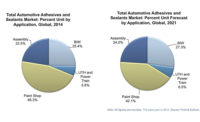4 Trends Impacting the Global Adhesives and Sealants Industry
The adhesives and sealants community will meet this month to discuss trends and new technologies at the ASC Fall Convention and Expo.






The Adhesive and Sealant Council (ASC) supports a $43 billion global industry whose reach spans all market segments and sub-segments. Though it focuses primarily on the $12 billion North American market, the association’s 131 member companies compete in a global community. Following are four trends the association is tracking within the global adhesives and sealants industry.
1. California and TSCA Reform
Adhesive and sealant manufacturers looking for common sense, science-based reform to the U.S. Toxic Substances Controls Act (TSCA), adopted in 1976, will have to hope that the chairman of the Senate Energy and Public Works Committee has a change in thinking during the weeks leading up to the fall adjournment. According to meetings attended by the ASC, senators, staff and interested groups lobbying for the bipartisan S 1009, all roads lead to Chairman Barbara Boxer (D-Calif.) and whether she is willing to discuss even allowing the bill to be voted on by the full committee.
The ASC isn’t holding its breath. TSCA reform was the primary issue facing the association when I joined in 2010, and it’s going to be the primary issue facing it in 2015.
Sen. Boxer—and any senator who does this type of stonewalling on other pieces of legislation—continues to do the American people a disservice. Our meetings clearly illustrate why many polls have Congress at a 7-12% approval rating. No debate is happening; this is not democracy, it’s just power. Only committee chairs can set the agenda for hearings, and Sen. Boxer isn’t budging on the federal preemption provisions written into Sen. 1009. There are likely many other reasons why her office isn’t supportive of the bill, but this is what many of her colleagues are quietly pointing to when we talk with them.
Sen. Boxer apparently believes her state is doing a fine job scrutinizing chemicals; let’s focus on that point in our next trend that is impacting the industry.
2. Flaws in DTSC Safer Consumer Product Rulemaking
As part of the new regulations under the California Safer Consumer Products law, the Department of Toxic Substances Control (DTSC) announced this spring the first three priority products that manufacturers will be required to consider reformulating with “safer” chemicals. To the ASC’s shock and disbelief, one of the nominees was “Spray Polyurethane Foam (SPF) Systems Containing Unreacted Diisocyanates.” In a sharply worded letter to the DTSC, the ASC attempted to alert the regulatory agency that there are significant flaws in their research. Following are a few examples.
• “Throughout this document, the department references many polyurethane applications that have absolutely nothing to do with spray polyurethane foam (SPF) systems—references to adhesives, coatings, truck bed liners are completely out of scope and should be withdrawn from this document to avoid future confusion for both regulators and the regulated community.”
• “MDI and its oligomers are the only polyisocyanates used in SPF systems. Yet throughout the document DTSC, both directly and through implication, inaccurately makes references to the presence of HDI and TDI as a minor component or as residual constituents in SPF systems. The inaccuracies in these statements are so basic that it can’t help but raise questions about the fundamental validity of the entire Priority Product profile.”
• “Similarly DTSC has defined the priority product in such a way as to lump together multiple chemistries and different application systems (aerosol one component foam systems vs. SPF spray foam systems). The Department has failed to recognize various application systems represent different exposures and therefore the amount of risk to those using these products. For example, one component foam (OCF) systems are not delivered as spray but are applied as a “beaded foam” and thus do not result in airborne exposures.”
The information is just plain wrong; so wrong, in fact, that one wonders how it got the attention of the regulators in the first place. Federal pre-emption needs to be in TSCA Reform so that ASC members don’t have to address these kinds of issues once the other 49 states start adopting the mistakes that California is making.
3. EPDsTake Hold
The macro trend of transparency in chemical formulation is gaining momentum within the building and construction sector. Due to the U.S. Green Building Council (USGBC) and its Leadership in Energy & Environmental Design (LEED) v4, in which the materials credit includes Environmental Product Declarations (EPDs), there has been an increase in the number of letters architects are writing to formulators, requesting they provide EPDs on every product they sell into the market.
The ASC and its members have no issues with information sharing; we’ve been doing this for years with MSDSs and now with the new GHS labels mandated by OSHA. However, what always must be kept in mind is that information shared in data sheets or labels concentrates on risk-based information. The ASC continues to focus on this one key aspect: risk modeling as it relates to chemicals. It’s crucial that the design engineering firms understand that this is risk modeling, not hazard. EPDs will allow for positive communication between suppliers and customers—but both need to be on the same page when it comes to the information the documents are expressing.
The ASC is now looking at how best to share data via EPDs. We have developed an EPD team that will review what is happening in Germany and the European Union, and will determine how workable solutions could be adopted to the North American market. Our next steps will be to discuss this in a joint conference call with our partners at IVK, the Germany-based association that focuses on adhesives. We will then talk with FEICA about possible approaches to moving forward and, ultimately, decide how we want to proceed.
4. Strong Opportunity in Central and South America
Finally, a good news trend! In 2013, the Central and South America region shipped more than 2.6 million lbs of adhesives and sealants. With a solid 5% compounded annual growth rate, the region is expected to grow to 3.2 million lbs of product sold by the end of 2017. The region is having something of an economic boom, with an expanding middle class, along with an increased awareness and acceptance of the new available technologies. These market drivers are providing a positive growth opportunity throughout the region, particularly in Brazil. Argentina, Colombia and Venezuela represent 85% of the market in terms of production volume, according to the ASC’s new “Central and South America Market Report.”
The report, commission by the ASC and its Global Resources Committee and produced by Frost and Sullivan, also explains why companies in Central and South America are buying adhesives and sealants. The report includes interviews with 50 end users and product buyers. Construction, transportation and assembly operations were all indicating strong growth positions as new buildings take shape, consumers start to buy more automobiles and companies move operations to the region to support the new growing middle class. Overall, the report indicates a strong opportunity for ASC members and industry, and is a good news area for companies looking to expand product penetration in this region.
Learning Opportunities
The ASC’s Fall Convention and Expo, which will be held October 20-22 at the Hyatt Regency Greenville in Greenville, S.C., will provide ample opportunities to learn more about these trends and other issues facing the adhesives and sealants industry. From engaging keynote speakers and insightful technical sessions to an Expo (see the exhibitor list and floor plan here), a short course on waterborne adhesives, and multiple networking opportunities, you won’t want to miss this.
For more information, contact the author at matt.croson@ascouncil.org or visit www.ascouncil.org.
Looking for a reprint of this article?
From high-res PDFs to custom plaques, order your copy today!








